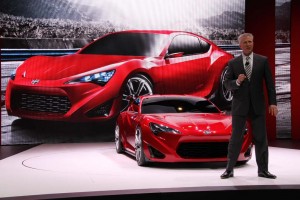Think of it as the Peter Pan brand, forever young. And that’s just the way Scion intends to stay despite recent rumors suggesting Toyota’s youth-oriented brand will shift its focus.
But don’t think there aren’t some big changes in the works, suggested Jack Hollis, the general manager of the Scion division. Quite the contrary. For one thing, the brand will be expanding its line-up. And some familiar nameplates will soon be going away – with some radically new alternatives taking the place of familiar offerings like the boxy xB.
Meanwhile, Scion’s success hasn’t been ignored by other regions of the far-flung Toyota empire. And so, while conceived specifically as a U.S. brand Scion very well could expand into other markets from China to the Middle East, officials told TheDetroitBureau.com in an exclusive interview.
“Scion will need to change and evolve because the younger generation is changing quickly,” said Hollis, stressing that the Millennial market is feeling the impact of not only the recession but economic changes likely to reach years into the future.
For one thing, the youngest generation of buyers may be the first to experience a decline in income when compared to their parents. But they’re also evolving the way they engage in community activities.
“Young buyers don’t look at needing a car as much today to have a social life. Their world of community is so much larger and they don’t need a car to take them there” because of smartphones, Twitter and texting, Hollis stressed. “We have to give them a reason to drive again and love a car. That why very excited about the FR-S.”
Scion’s latest entry was developed as part of a joint venture between parent Toyota and Subaru – which is marketing a version of the 2-seater as the BRZ.
It is joined in the Scion line-up by the iQ microcar. Similar in size to the unloved Smart fortwo, Scion is hoping to do a better job connecting to potential buyers with the minicar, which has been on sale in Europe through the Toyota brand for several years.
“How Scion does with the iQ will direct us” in planning future products, said Hollis. Despite slow sales in the microcar segment he believes it is only a matter of time until they gain traction, especially among younger buyers sensitive to fuel prices – and more willing to move back into urban communities. “It would be a surprise to me if we don’t see more small cars in the U.S.”
With the addition of the FR-S and iQ the Scion line jumps to five models – a distinct shift in strategy for a brand that originally intended to stick with just three offerings. But Scion hasn’t changes as much as that might seem, the executive insisted. For one thing, it remains an experimental lab for Toyota, which means that once familiar names could go away – soon – in search of new alternatives.
Among the most models is the slow-selling Scion xD. It is “likely” to be replaced, according to Hollis, with a new model possibly reviving the old Scion xA nameplate.
Recent reports have suggested that Scion will also eliminate the boxy xB, once the icon of the brand. It is clear that the second-generation model hasn’t had the pulling power of the original, but talk of its demise “is not true,” according to Hollis. Not imminently, anyway. The xB will remain part of the Scion line-up “for several more years.” What happens then still has “not been determined yet.”
That likely translates into an all-new product and not just another box-mobile, however, though Hollis hinted that “Our plan is to replace the space the xB lives in” with another “iconic vehicle that plays in the same space,” translating into a “subcompact, sub-$20,000” offering.
With a truly significant shift in direction, Hollis added, the xB name could also be dropped.
As to reports that Scion is shifting away from younger buyers, Hollis is absolute. Not a chance. Since its debut, nearly nine years ago, Scion has always had the lowest average age of any mainstream brand and it intends to keep that position.
How, remains to be seen, as Hollis noted, and the debate will likely have a significant impact on future products. One argument suggests a greater emphasis on technology, especially in the connected vehicle space. The other line of thought is that Scion should emphasize lower-tech, fun-to-drive models like the FR-S.
Perhaps surprisingly, Scion has yet to add a hybrid to its line-up and Hollis firmly says there are no plans to add a dedicated, Prius-style model. But referring to Toyota CEO Akio Toyoda’s promise to offer a hybrid drive package for virtually all of the company’s products, Hollis says Scion could eventually add a gas-electric option.
“Everything is on the table,” acknowledged Scion chief Hollis, even the brand’s unique focus on the American market.
His counterparts in many parts of world – especially China and the Mideast – “have shown much interest in Scion….and there’s been a lot of discussion globally about how Scion might fit in” elsewhere. A decision “is not imminent at this point,” Hollis added, but it is just one of the many issues the brand is dealing with as it approaches the end of its first decade on the market.


I had been waiting over a year and a half for the iQ to come out, and had every intention of buying the first one my local dealer got on the lot – until I found out that cruise control wasn’t available, even as a dealer add-on. Total deal breaker for me – so I leased a fortwo (with factory cruise) instead.
But I’d rather have had the iQ…
It blows my mind that Toyota markets the iQ as a ‘premium micro-car’ at a pretty premium price and it doesn’t even have cruise. Very disappointed.
WLB.